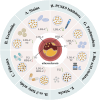Research trends in lipid-lowering therapies for coronary heart disease combined with hyperlipidemia: a bibliometric study and visual analysis
- PMID: 38828451
- PMCID: PMC11140088
- DOI: 10.3389/fphar.2024.1393333
Research trends in lipid-lowering therapies for coronary heart disease combined with hyperlipidemia: a bibliometric study and visual analysis
Abstract
Background: Cardiovascular disease (CVD) poses a significant global health and economic challenge, with atherosclerosis being a primary cause. Over the past 40 years, substantial research has been conducted into the prevention and reversal of atherosclerosis, resulting in the development of lipid-lowering agents such as statins and fibrates. Despite the extensive literature and formulation of numerous therapeutic guidelines in this domain, a comprehensive bibliometric analysis of the current research landscape and trends has not been performed. This study aimed to elucidate the evolution and milestones of research into lipid-lowering treatments for coronary heart disease (CHD) in conjunction with hyperlipidemia through bibliometric analysis, offering insights into future directions for treatment strategies.
Methods: This study examined publications from 1986 to 2023 retrieved from the Web of Science database (Core Collection). Utilizing tools such as VOSviewer, Pajek, and CiteSpace, we analyzed publication and citation numbers, H-indexes, contributions by countries and institutions, authorship, journal sources, and keyword usage to uncover research trajectories and areas of focus.
Results: Our analysis of 587 publications revealed a recent surge in research output, particularly post-2003. The American Journal of Cardiology published the highest number of studies, with 40 articles, whereas Circulation received the highest number of citations (6,266). Key contributors included the United States, Japan, and China, with the United States leading in citation numbers and the H-index. Harvard University and Leiden University emerged as pivotal institutions, and Professors J. Wouter Jukema and Robert P. Giugliano were identified as leading experts. Keyword analysis disclosed five thematic clusters, indicating a shift in research towards new drug combinations and strategies, signaling future research directions.
Conclusion: The last 4 decades have seen a notable rise in publications on lipid-lowering therapies for CHD and hyperlipidemia, with the United States retaining world-leading status. The increase in international collaboration aids the shift towards research into innovative lipid-lowering agents and therapeutic approaches. PCSK9 inhibitors and innovative combination therapies, including antisense oligonucleotides and angiopoietin-like protein 3 inhibitors, provide avenues for future research, intending to maximize the safety and efficacy of treatment approaches.
Keywords: CiteSpace; VOSviewer; coronary heart disease; hyperlipidemia; lipid-lowering therapy; visualization analysis.
Copyright © 2024 Cheng, Sun, Zhong, Wang, Liu, Zhou and Deng.
Conflict of interest statement
The authors declare that the research was conducted in the absence of any commercial or financial relationships that could be construed as a potential conflict of interest.
Figures










References
-
- Aung T., Halsey J., Kromhout D., Gerstein H. C., Marchioli R., Tavazzi L., et al. (2018). Associations of omega-3 fatty acid supplement use with cardiovascular disease risks: meta-analysis of 10 trials involving 77 917 individuals. JAMA Cardiol. 3 (3), 225–234. 10.1001/jamacardio.2017.5205 - DOI - PMC - PubMed
LinkOut - more resources
Full Text Sources
Miscellaneous

